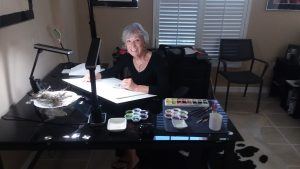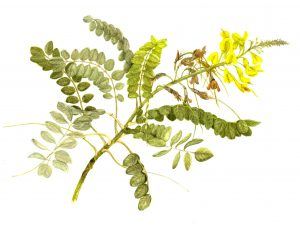“Skyway 20/21” Artist Check-ins: Lynne Railsback
In this Artist Check-in, Lynne Railsback tackles some questions regarding her technical practice and the conceptual drive behind her highly detailed, realistic watercolor paintings. Working between Florida and Wisconsin, Railsback (pictured below) investigates and celebrates plant species native to each location. Here she is pictured in her studio, where she works directly from plant specimens.
Railsback was born in 1944 in New London, Connecticut. Although she grew up in an artistic family, she did not turn to painting until after retiring as a commercial interior designer. Her work has been shown throughout the United States as well as the United Kingdom, often in thematic exhibitions that focus on the effects of climate change and invasive plant species. These are themes that drive her practice, with the mission of educating her audiences on the importance of maintaining the health of native plants. Learn more in the short Q&A below:
Could you tell us about your lift-out technique, and explain why it’s unusual for a botanical watercolor artist to work directly from specimens?
My approach to a painting is different from most botanical artists. They may have the specimen in front of them or work from a photograph, but they typically do a series of pencil sketches and color studies. Once they are comfortable with their compositions, they trace the drawing on the watercolor paper and then begin the painting process. I do not do preliminary studies or rely on photographs. My approach is to arrange the actual specimen in a pleasing composition on a board or have the potted plant situated in front of me. I use a limited palette of five pigments, which I mix to achieve the appropriate color scheme. I then begin applying pigment to the paper. When areas have dried, I move and remove portions of color with a minute wet brush. This “lift-out” technique allows me to create a detailed portrait of the object. I prefer my technique as it allows me to be more creative.
What drew you to the investigation of invasive and native plant species? And how does your practice differ based on location? I know you practice in the Midwest as well the subtropics of Florida.
In botanical art, it is a requirement to portray the plant accurately in form, size and color as well as create beautiful work. Some exhibitions also want to know if the plant is native or invasive. During the research process, I learned that many native plants were threatened by introduced, invasive plants. I continue to represent both and focus on exhibitions whose purpose is to educate the viewer on the importance of native species. The only difference between how I work in Wisconsin verses Florida lies in the available specimens.
During this period of global self-isolation, we have seen examples of the natural world responding to lessened human activity and interaction: reduced smog patterns around the world, coyotes roaming around San Francisco, carbon dioxide emissions dropping significantly are just some examples. Waterways may replenish and development projects may be halted. How do you envision the natural world responding to this unprecedented occurrence, and what lessons can we glean from the natural world’s adaptation to our new (temporary) normal?
Although COVID-19 has reduced some of the factors that negatively affect our environment, I believe we will go back to our old ways once the virus is controlled. People began to demonstrate against following the guidelines prior to their being lifted. There may be a reduction in some activities, but I believe a long-term stimulus package is required to build stronger economies and ensure the health and wellbeing of peoples throughout the world. If we listen to the experts on climate change like we have with the doctors during this pandemic, perhaps there is a chance we can reverse this trend.

